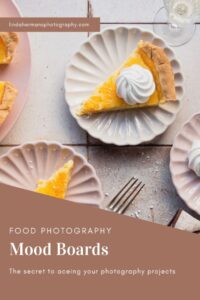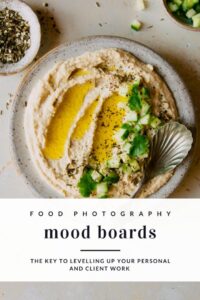Creating mood boards for food photography projects is a great way of developing your personal style over time as well as building a strong communication with your clients when interpreting their project briefs.
In this post we'll talk through what mood boards are and how to create them. Then we'll look at how to apply them to your personal photography development and client work.
Let's dive in!

What is a mood board?
A mood board is a collection of visual content that represents a particular concept or idea.
You might also hear them being called vision boards, and it's the same thing.
I say visual content rather than only photography because any type of visual media could be included in a mood board, from photos and videos to colour palettes, key words and other design elements.
It's essentially a collage and it can be created digitally or physically depending on how you prefer to do things!
How to create mood boards for food photography
It's really very simple to create a mood board, especially if it's a digital one.
You can use any program or tool you're most comfortable with to put together the images for your mood board, whether it's a Word or Pages document, a presentation or - my preferred tool - Canva.
Canva is great because it provides lots of different formats and templates for mood boards and all you need to do is upload the media you wish, then drag and drop it into the templates.
In the sections below I'll go through some specific steps for creating mood boards for personal work and client work.
If you're new to mood boards and would love some help creating your first one, I've created five free Canva templates for you to use straight away! Just sign up to my mailing list to become a free member and access a bunch of exclusive freebies and resources!
Get five free Canva templates and create you first mood board
get started now!

Example mood board for food photographers wanting to identify and develop their personal style.
Mood boards for personal work in food photography
I'm pretty sure everyone struggles to find their personal style when they start any creative endeavour.
I remember feeling so inspired by all the talented photographers I was discovering on social media, then excited to experiment with different styles (dark and moody, light and bright, modern, vintage...) in the hope of having the "aha" moment when one particular style would stick.
After some time though, despite seeing an improvement in my photos from a technical aspect, I felt that I wasn't actually getting any closer to creating images that felt like me. I was feeling really frustrated that I couldn't see a clear style emerging in my portfolio or my Instagram feed.
That all changed when I started creating mood boards for myself.
I have Lucia Marecak @foodlight.io to thank for introducing me to the idea of personal mood boards! I created my first one in 2020 and have made a new one each year since.
Personal mood boards are really helpful because:
- they show all the images that inspire you in one place, making it easier to identify patterns, light and colours that you like
- you can create a new one as often as you like, which means they evolve and change with your tastes
- you can make just one or multiple boards for different interests (e.g. product, restaurant, dark and moody etc).
- you can set them as your desktop wallpaper so you see them everyday
Here are some step-by-step instructions for creating a personal mood board for food photography and how it can guide you towards your creative style.
- Browse social media platforms and the portfolios of photographers you admire to save images that you wish you'd taken yourself (you can just screenshot them)
- Narrow them down to a final selection of between 10-20 images and put them together on a single page
- Analyse the images. Are there any colours, styles, angles that repeat? Do you see more warm or cool tones? Are they modern or vintage styles? Light and bright or dark and moody?
- Plan some shoots to recreate some of these images. This will help you to practice these styles and techniques and start creating them in your own way.
- Save the mood board as your desktop wallpaper so you see if often and let it inspire you every day!
- Review and update your mood board at least every 12 months if not more regularly. Don't be afraid of recognising and making big changes - the mood board will change with your growth and development.

Above is my mood board for 2022. I wanted to explore more food photography outside of my studio and look for new clients or opportunities to work with restaurants and hotels. My mood board for earlier years were very different and the one for 2023 is also very different!
Mood boards for food photography client projects
Let's turn to client work and how mood boards can be used in the initial stages of a new client project.
When I speak with a client about their upcoming campaign or brief, I like to ask them lots of questions to find out what their vision is for the final images. I want to know which colours and textures they want to use, whether they imagine including a human element, are the shots wide or close-up, and so on.
All this information helps me clarify what the client expects when I deliver the images. It's fine to have this information in writing and signed off by the client before the shoot, but what I find really helps my clients feel confident and assured that I'm going to deliver, is sending over a mood board with images that reflect what they've told me.
A mood board that reflects their vision shows the client that I've listened and understood their needs. It builds trust between us and means that I can go into the shoot feeling confident too.

Example mood board for a restaurant client. Images are by Linda Hermans.
Client mood boards can be as simple as a collection of 8-10 images that represent what they have told you in the project brief, or can also include some key words about colours and atmosphere that you will capture.
The images within a mood board can be your own work from past personal or client work (as long as they are relevant to the specific project) or reference images that you have found online if you don't have anything relevant in your portfolio yet but are confident you can execute.
You can also ask your client to send you examples of images they love and include them in the mood board - this will make your life much easier!
Above is an example mood board for a cafe or restaurant client who would like fresh, vibrant images of the items on their menu as well as interiors. They want to show what the customer experience is like, so using models to add a human element would work well for them to show the social aspect of the establishment. All the images were taken by me for Apple Butter Cafe throughout 2022.
When to share mood boards with clients
In my experience, there are a couple of moments in the client communication process where you could present a mood board.
One is before you've secured the project but you want to give the client a little extra boost of confidence that you've got this. I have often done this when I'm pitching ideas to larger clients or clients in a new niche for me (e.g travel).
Another moment to share a mood board is once you've signed the contract and are preparing for the shoot. I usually do this for repeat clients and new restaurant clients.
Repeat clients already know I can do the job and they simply have a new brief for a specific campaign or new product. Restaurant clients can view my portfolio to decide whether they like my overall style and then the mood board will be for me to get a clear vision of what they want for their restaurant.

Example mood board for a client looking for product photography. Images are by Linda Hermans.
I hope you enjoyed this post about mood boards for food photography! If you have any comments or questions about creating and using mood boards for personal and client projects, I'd love to hear them! Leave them below and I'll get back to you!
Pin me for later!



0 comments